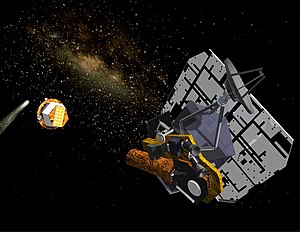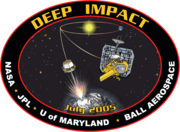
Back ديب إمباكت (مسبار فضائي) Arabic Дийп Импакт Bulgarian ডিপ ইম্প্যাক্ট (মহাকাশযান) Bengali/Bangla Deep Impact Catalan Deep Impact (sonda) Czech Deep Impact (Raumsonde) German Deep Impact (sonda espacial) Spanish برخورد ژرف (فضاپیما) Persian Deep Impact (luotain) Finnish Deep Impact (sonde spatiale) French
 Artist's impression of the Deep Impact space probe after deployment of the Impactor | |
| Mission type | Flyby · impactor (9P/Tempel) |
|---|---|
| Operator | NASA · JPL |
| COSPAR ID | 2005-001A |
| SATCAT no. | 28517 |
| Website | www |
| Mission duration | Final: 8 years, 6 months, 26 days |
| Spacecraft properties | |
| Manufacturer | Ball Aerospace · University of Maryland |
| Launch mass | Total: 973 kg Spacecraft: 601 kg (1,325 lb)[3] Impactor: 372 kg (820 lb)[3] |
| Dimensions | 3.3 × 1.7 × 2.3 m (10.8 × 5.6 × 7.5 ft)[3] |
| Power | 92 W (solar array / NiH2 battery)[3] |
| Start of mission | |
| Launch date | January 12, 2005, 18:47:08 UTC |
| Rocket | Delta II 7925 /PAM-D |
| Launch site | Cape Canaveral SLC-17B |
| Contractor | Boeing |
| End of mission | |
| Disposal | Contact lost |
| Last contact | August 8, 2013 |
| Flyby of Tempel 1 | |
| Closest approach | July 4, 2005, 06:05 UTC |
| Distance | 575 km (357 mi) |
| Tempel 1 impactor | |
| Impact date | July 4, 2005, 05:52 UTC |
| Flyby of Earth | |
| Closest approach | December 31, 2007, 19:29:20 UTC |
| Distance | 15,567 km (9,673 mi) |
| Flyby of Earth | |
| Closest approach | December 29, 2008 |
| Distance | 43,450 km (27,000 mi) |
| Flyby of Earth | |
| Closest approach | June 28, 2010, 22:25:13 UTC |
| Distance | 30,496 km (18,949 mi) |
| Flyby of Hartley 2 | |
| Closest approach | November 4, 2010, 13:50:57 UTC |
| Distance | 694 km (431 mi) |
 Official insignia of the Deep Impact mission | |
Deep Impact was a NASA space probe launched from Cape Canaveral Air Force Station on January 12, 2005.[4] It was designed to study the interior composition of the comet Tempel 1 (9P/Tempel), by releasing an impactor into the comet. At 05:52 UTC on July 4, 2005, the Impactor successfully collided with the comet's nucleus. The impact excavated debris from the interior of the nucleus, forming an impact crater. Photographs taken by the spacecraft showed the comet to be more dusty and less icy than had been expected. The impact generated an unexpectedly large and bright dust cloud, obscuring the view of the impact crater.
Previous space missions to comets, such as Giotto, Deep Space 1, and Stardust, were fly-by missions. These missions were able to photograph and examine only the surfaces of cometary nuclei, and even then from considerable distances. The Deep Impact mission was the first to eject material from a comet's surface, and the mission garnered considerable publicity from the media, international scientists, and amateur astronomers alike.
Upon the completion of its primary mission, proposals were made to further utilize the spacecraft. Consequently, Deep Impact flew by Earth on December 31, 2007, on its way to an extended mission, designated EPOXI, with a dual purpose to study extrasolar planets and comet Hartley 2 (103P/Hartley).[5] Communication was unexpectedly lost in August 2013 while the craft was heading for another asteroid flyby.
- ^ Ray, Justin (January 9, 2005). "Delta Launch Report: Overview of NASA's Deep Impact comet mission". Spaceflight Now. Retrieved January 7, 2010.
- ^ "Deep Impact (EPOXI): Key Dates". NASA. Archived from the original on November 14, 2016. Retrieved November 12, 2016.
- ^ a b c d "Deep Impact Launch: Press Kit" (PDF). NASA. January 2005. Archived from the original (PDF) on June 26, 2021. Retrieved July 3, 2018.
- ^ Cite error: The named reference
SFN Overwas invoked but never defined (see the help page). - ^ Tune, Lee; Steigerwald, Bill; Hautaluoma, Grey; Agle, D.C. (December 13, 2007). "Deep Impact Extended Mission Heads for Comet Hartley 2". University of Maryland, College Park. Archived from the original on June 20, 2009. Retrieved August 7, 2009.